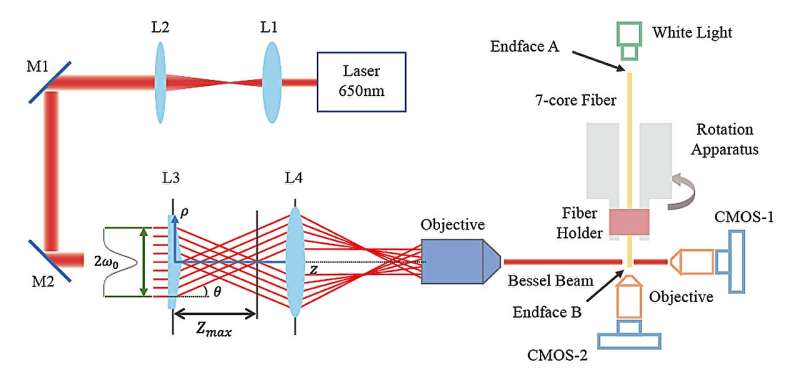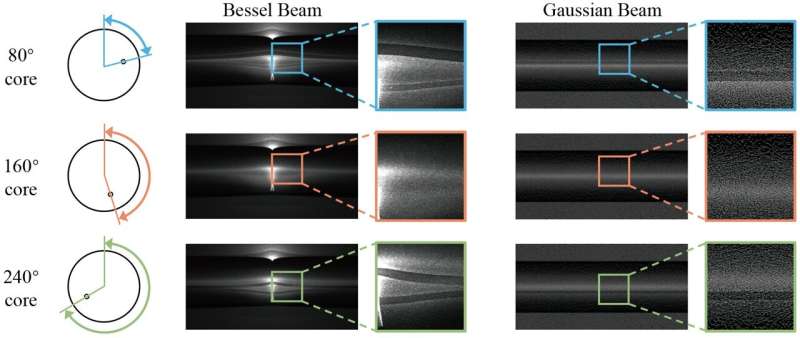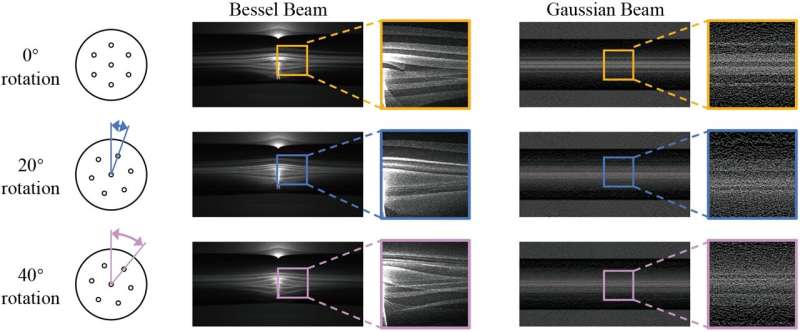This article has been reviewed according to Science X's editorial process and policies. Editors have highlighted the following attributes while ensuring the content's credibility:
fact-checked
trusted source
proofread
Bessel-beam-based side-view measurement of seven-core fiber internal core distribution

Optical fiber, as the basic carrier of modern high-speed and high-capacity communication, is the key to the interconnection of the world. With the rapid development of the communications industry in recent decades, ordinary single-mode optical fiber can no longer meet the special needs of various industrial applications, so a series of optical fibers with complex internal structures, such as polarization-maintaining fibers, multi-core fibers and photonic crystal fibers, and other specialty optical fibers came into being in the civil and military fields are indispensable.
The variety of these specialty fibers and their complex internal structures have limited their manufacturing monitoring, fiber splicing, and micro–nano processing to some extent. Existing methods such as end-view inspection, digital holographic, optical tomography, polarization observation by lens-effect-tracing, and Gaussian scattering imaging have specific problems that do not meet the current needs.
In a new paper published in Light: Advanced Manufacturing, a team of scientists, led by Professor Fei Xu from College of Engineering and Applied Sciences and Collaborative Innovation Center of Advanced Microstructures, Nanjing University, China, and co-workers have developed a method to use Bessel beam (a structured light) as an illumination light source, and transmit from the side of a seven-core fiber to perform imaging (shown in Figure 1).
The advantages of Bessel beam illumination over traditional methods are verified by the digital correlation method, and at the same time, combined with the deep learning method, a high-precision measurement of the internal structure of the seven-core optical fiber is realized.

Simulation studies show that the self-healing property of the Bessel beam, as a non-diffraction structured light, provides a long depth of focus in the scattering medium, resulting in less scattering, sharper fiber core patterns, and higher image contrast in Bessel beam-based illumination imaging. In addition, Bessel beams provide a unique effect when transmitting an off-axis object with an internal transparent medium with a varying refractive index (as shown in Figure 2), which produces two refractive paths with different bending curvatures.
Based on the above two features, compared to Gaussian beam illumination, images from Bessel beam illumination could see more fiber cores when imaging specialty fibers with different rotation angles (shown in Figure 3). As verified by the digital correlation method, the image change based on Bessel beam is much faster than that of Gaussian beam, and the measurement precision is higher.

In this paper, the precision of the measurements was further improved by using deep learning. The deep learning model processes the captured image and directly outputs the predicted fiber rotation angle. In addition, the researchers also collected images of fibers which different from those of the fiber used in establishing the training database, and input them to the trained deep learning model, whose prediction results also achieved good precision and accuracy, indicating that the deep learning method has a strong generalization ability and good robustness in practical applications.
The results show that the Bessel beam-based approach has great potential for developing applications for precise and nondestructive measurements of core distributions in multicore fibers and photonic crystal fibers.
More information: Liuwei Zhan et al, Bessel-beam-based side-view measurement of seven-core fibre internal core distribution, Light: Advanced Manufacturing (2023). DOI: 10.37188/lam.2024.002
Provided by Chinese Academy of Sciences




















